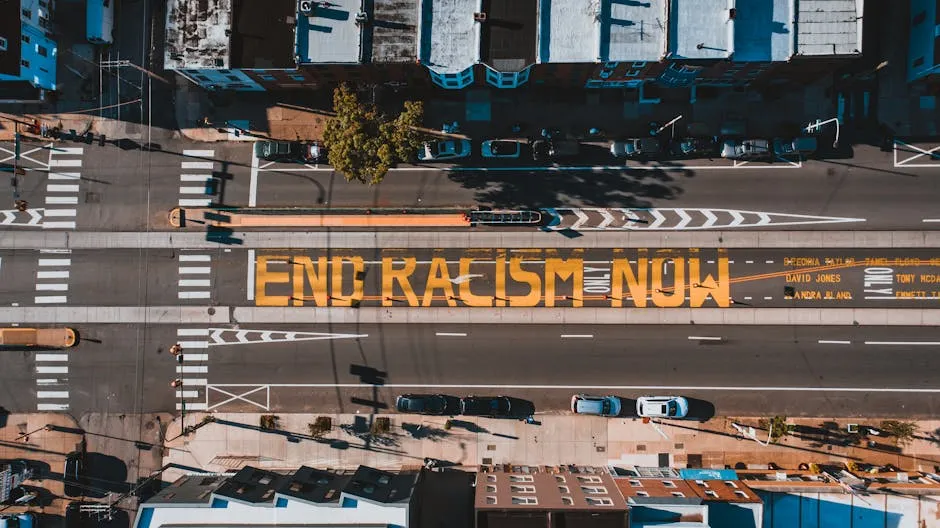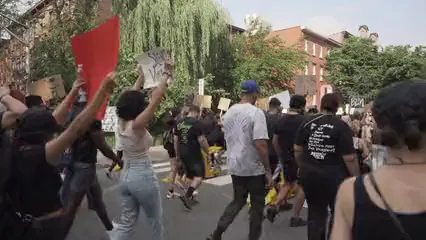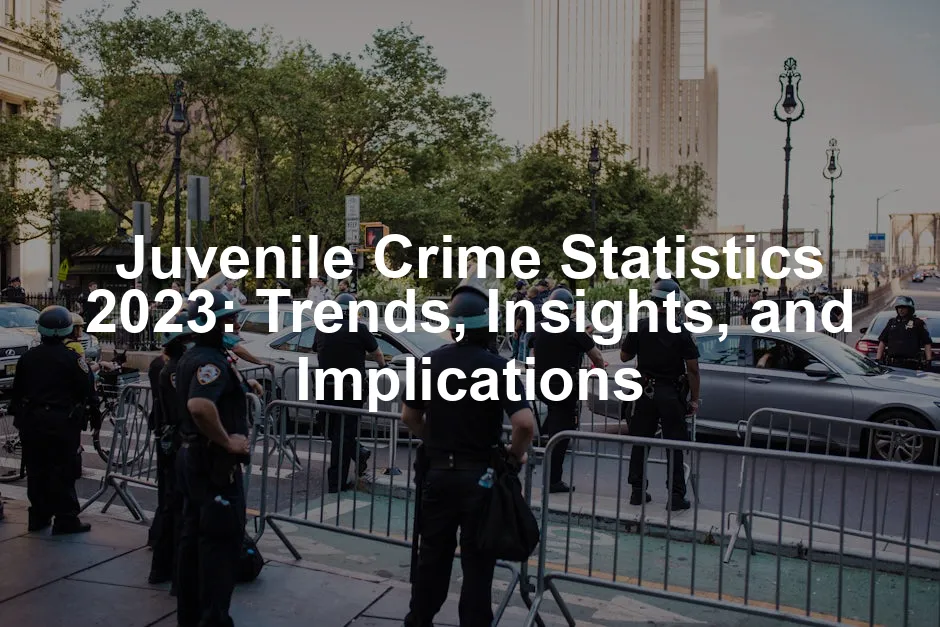Introduction
Juvenile crime statistics are more than just numbers; they represent the pulse of our society’s youth. Understanding these statistics can help us grasp the challenges faced by our communities today. Tracking these numbers is essential for identifying trends, shaping policies, and implementing effective interventions. The implications of juvenile crime extend beyond the individuals involved; they impact families, neighborhoods, and entire communities.
This article aims to analyze the juvenile crime statistics from 2023. We will explore emerging trends, significant increases in specific offenses, and their implications for communities and the juvenile justice system. By understanding where we stand, we can better formulate potential solutions to address these pressing issues.
The relevance of these statistics cannot be overstated. They inform lawmakers, educators, and community leaders about the current state of juvenile crime. They highlight the need for targeted interventions and preventive measures. As crime rates fluctuate, understanding the underlying causes becomes crucial. Communities grappling with rising juvenile crime face challenges in public safety, community trust, and economic stability. Thus, armed with data, we can strategize effectively and foster a safer environment for our youth.

Understanding the current trends in juvenile crime statistics is vital for effective policy-making. juvenile crime statistics 2023
1. Current Juvenile Crime Statistics Overview
1.1 National Trends in Juvenile Crime
According to the FBI’s 2023 report, juvenile crime is on the rise. There’s a concerning nearly 10% increase in juvenile violent crime compared to 2022. That’s not just a minor uptick; it indicates a significant shift in how youth engage in criminal behavior. Property crimes involving juveniles have skyrocketed by approximately 30% during the same period. In numbers, this translates to 34,413 juveniles accused of violent crimes, up from 31,302 in 2022. Property crimes saw a jump from 56,674 to 73,332 incidents involving juveniles.
Comparing these statistics with previous years provides an alarming perspective. The increases in both violent and property crimes suggest a trend that could destabilize communities. Public safety is directly affected, as these statistics indicate a higher likelihood of youth engaging in harmful behaviors. It raises questions about the effectiveness of current prevention and intervention strategies within the juvenile justice system.
Understanding the significance of these data points is crucial. They not only reflect the immediate concerns for public safety but also highlight the need for systemic changes. Communities must rally together to address this issue, engaging in conversations about prevention, intervention, and rehabilitation for at-risk youth. The rise in crime among juveniles is a call to action for policymakers and community members alike to take proactive steps toward creating safer environments for our children and teenagers.

As we navigate these troubling statistics, it is essential to remember the potential for positive change. Communities can implement programs that focus on prevention and rehabilitation. By investing in youth development, mental health resources, and educational opportunities, we can tackle the root causes of juvenile crime. Speaking of youth development, consider checking out Youth Development Program Materials that can help guide interventions aimed at nurturing young minds.
1.2 Regional Insights
Case Study: Baltimore
Baltimore has been making headlines for all the wrong reasons. From 2021 to 2024, juvenile crime has skyrocketed by a staggering 208%. Yes, you read that right! This isn’t just a small bump; it’s a colossal leap. In 2021, 191 juveniles faced charges. By 2023, that number jumped to 304, and the latest figures show a jaw-dropping 590 cases in 2024. Specific offenses are particularly alarming. Car thefts and carjackings increased by 158%. Robberies? A whopping 1,347% increase! It seems our young people are becoming increasingly bold in their criminal pursuits. Deputy State’s Attorney Catharine Rosenblatt expressed her deep concern, noting, “We’re seeing more and more violent crimes from kids at a younger and younger age.”

Case Study: North Carolina
Turning our gaze to North Carolina, the state reports a delinquency rate of 29 juveniles per 1,000 youth aged 8 to 17. This figure marks an uptick from 26 in 2022. The data shows that 32% of complaints were for school-based offenses, consistent with the previous year. The top three offenses? Simple assault, breaking or entering a motor vehicle, and simple affray. These trends highlight the ongoing challenges schools face in maintaining safety. It’s not just numbers; these are real issues impacting students and educators alike. The state has witnessed a steady increase in juvenile complaints, reaching a total of 39,341 in 2023, up from 35,894 the year before. North Carolina is grappling with a significant youth crime dilemma that demands attention.
International Perspectives
Juvenile crime isn’t just a U.S. problem; it’s a global issue. In Germany, statistics reveal a concerning trend, with crimes committed by children rising by a third in 2022. The Federal Criminal Police Office reported that 5.6 million crimes were registered, marking an 11.5% increase from 2021. Young suspects under 14 years old have surged by 35.5%. In England, the Youth Justice Statistics for 2022 to 2023 show an uptick in arrests of children, with a 9% increase to around 59,000 arrests. School-based offenses also remain a significant concern. These trends underscore the need for a comprehensive approach to address the societal impacts of rising juvenile crime globally. Young offenders are not just numbers; they are our future, and their behavior affects communities across borders.

2. Demographics of Juvenile Offenders
2.1 Age and Gender Distribution
Understanding the demographics of juvenile offenders is essential for addressing the root causes of crime. In 2023, a striking pattern emerged regarding age and gender distribution among juvenile offenders. The majority of juvenile crimes are committed by individuals aged 15 to 17. This age group constitutes a significant portion of arrests, accounting for around 76% of all juvenile offenses.
Interestingly, while both genders are involved in juvenile crime, the types of offenses frequently differ. Boys are more likely to commit violent crimes, such as assault and robbery, whereas girls often find themselves involved in non-violent offenses, including theft and status offenses like running away from home. This disparity highlights the need for gender-specific interventions in juvenile justice systems.
Furthermore, racial and ethnic disparities in juvenile crime statistics cannot be overlooked. Youth of color face disproportionately higher rates of incarceration. In 2021, Black youth were arrested at a rate of 2,487 per 100,000, compared to 1,080 for their white counterparts. These disparities raise critical questions about systemic biases in the juvenile justice system and the social factors contributing to these alarming statistics.

The rise in juvenile crime, particularly among youth of color, demands urgent attention. Factors such as socio-economic conditions, educational disparities, and family dynamics play a role in shaping these statistics. Communities must engage in meaningful dialogues to address these disparities, ensuring that all young people have access to the resources and support needed to thrive.
2.2 Factors Influencing Juvenile Crime
Several interconnected factors contribute to juvenile crime rates. One of the most significant influences is socioeconomic status. Poverty often drives youth toward criminal activity as a means of survival. Families struggling to make ends meet may inadvertently push their children into environments where crime seems like the only option.
Education is another critical factor. Schools that lack adequate resources can fail to engage students, leading them to seek fulfillment elsewhere. Failure to provide quality education can create a cycle where youth feel disconnected from society, making crime more appealing. Additionally, family structures play a vital role. Youth from broken or unstable homes may lack the guidance needed to navigate challenges, increasing their likelihood of engaging in criminal behavior.
Mental health issues are also prevalent among juvenile offenders. Studies indicate that a staggering 98.2% of juveniles committed to youth development centers have at least one mental health diagnosis. Many of these young people struggle with conditions such as depression, anxiety, and behavioral disorders. The complexities of mental health challenges often go unnoticed, leading to misguided perceptions of juvenile offenders as merely “bad kids.”

Addressing these contributing factors requires a multi-faceted approach. Effective intervention programs should focus on strengthening family units, enhancing educational opportunities, and providing mental health resources. By fostering environments that support youth development, communities can combat the underlying issues driving juvenile crime. For example, consider using a Mental Health First Aid Kit to equip communities with the tools to address these pressing needs.
In summary, the demographics of juvenile offenders reveal a complex interplay of age, gender, race, and socio-economic factors. Understanding these patterns is essential for creating effective strategies to reduce juvenile crime rates and promote healthier, more vibrant communities.
2.3 Policy Implications
Need for Reform
The recent surge in juvenile crime statistics is a wake-up call. It’s time for a serious reassessment of our juvenile justice system. With juvenile violent crime up nearly 10% and property crimes soaring by approximately 30%, we can’t ignore the urgent need for reform. These statistics reveal a troubling reality: the current system isn’t effectively addressing the complexities of youth crime. A fresh, innovative approach is essential to tackle these rising numbers. We must prioritize reform that emphasizes rehabilitation over punishment. After all, young offenders are still impressionable and deserving of second chances.

Evidence-Based Interventions
Addressing juvenile crime requires more than just policy changes; it demands evidence-based interventions. Community programs that focus on mentorship and skill development have shown promise. These initiatives can provide at-risk youth with positive role models and constructive activities. Mental health support is equally vital. Many juveniles involved in crime struggle with untreated mental health issues. By integrating mental health resources into community programs, we can address the root causes of delinquency. It’s about creating environments where young people feel valued and supported. Speaking of support, consider checking out Self-Help Books for Teens that can empower youth to make positive life choices.

2.4 Community Involvement
Role of Schools and Communities
Schools and communities play a pivotal role in reducing juvenile crime. They are on the front lines, interacting with young people daily. By fostering a sense of belonging and encouraging engagement, communities can deter youth from criminal behavior. Schools, in particular, are crucial in creating safe spaces for students. Implementing programs that teach conflict resolution and social skills can significantly impact students’ choices. After all, a supportive school environment often translates to lower crime rates. If you’re looking for tools to facilitate these programs, consider Conflict Resolution Skills Workbook that can provide valuable guidance.

Programs and Initiatives
Several successful programs have emerged, demonstrating the power of community involvement. For instance, mentorship programs that connect youth with community leaders have shown a decrease in delinquency rates. Organizations like Big Brothers Big Sisters provide positive influences that can steer youth away from crime. Additionally, initiatives focusing on after-school activities help fill the void that often leads to risky behavior. By investing in these programs, communities can foster safer environments, ultimately reducing juvenile crime rates. And speaking of after-school activities, why not explore some Educational Board Games that can engage youth in positive, constructive ways?

FAQs
What are the most common types of juvenile crimes?
Juvenile crimes often include theft, assault, and drug offenses. Recent trends show a rise in property crimes and school-based offenses, reflecting broader societal issues.
How does juvenile crime differ by region?
Juvenile crime varies significantly across regions. For example, urban areas tend to experience higher rates of violent crime, while rural areas may see more property crimes.
What are the long-term effects of juvenile crime on offenders?
Long-term effects include difficulties in education and employment. Many juvenile offenders struggle with recidivism, affecting their ability to reintegrate into society successfully.
How can communities help reduce juvenile crime?
Communities can reduce juvenile crime by implementing mentorship programs, offering recreational activities, and providing mental health resources to at-risk youth.
What resources are available for at-risk youth?
Numerous programs exist to support at-risk youth, including local mentoring organizations, after-school programs, and mental health services aimed at helping them avoid criminal behavior.
Please let us know what you think about our content by leaving a comment down below!
Thank you for reading till here 🙂
All images from Pexels




